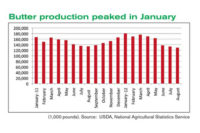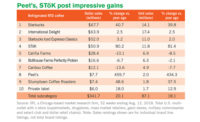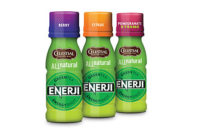
Ready or Not
by Shonda Talerico Dudlicek
Contributing Editor
Here comes the future of dairy packaging — some say it’s aseptic, and it should be sustainable.
Could this be the year of
aseptic? Could this be the year that American consumers wake up and say,
“Yeah, gimme my milk straight out of the box!”
Aseptic and ultra-high temperature (UHT) processing are
changing the milk category. Aseptic processing allows for ambient
temperature distribution and merchandising as well as a 6-month shelf life.
UHT processing adds 30 to 60 days to shelf life.
These processes, especially aseptic, open up or
simplify milk sales in other departments in the store such as deli and
bakery and different distribution channels, such as direct-store delivery
to convenience stores, vending and even NFL stadiums. And proponents say
aseptic packaging is “green” because it’s easily recycled
and takes less energy to store and transport.
“With consumers becoming more and more interested
in sustainability, they are seeking environmentally friendly products now
more than ever,” says Molly Watson, associate brand manager at
Phoenix-based Shamrock Farms. “It will be important for dairy
processors to continue to explore what opportunities there are in
sustainable packaging now and in the future.”
Consumers Not Ready?
Dairy processors should welcome shelf-stable milk, says
Lisa Pierce, editor in chief of Food and Drug
Packaging, but “American consumers are not
ready. Processors can gain with refrigerated transportation by going to
aseptic and to request or demand that retailers sell the product in the
refrigerated section.”
Organic Valley Family of Farms, LaFarge, Wis., has
found success with its aseptic single-serve organic milk. The cooperative
introduced a 24-pack of single-serve 1 percent milk earlier this year,
aimed squarely at children; Organic Valley also offers four-packs at
retail.
“Our single-serve sales are good. The focus is on
camping, sailing, backpacking and pantrying to stock up in
emergencies,” says Eric Newman, Organic Valley’s vice president
of sales. “We want grab-and-go as our primary placement, then in the
dry grocery aisle with aseptic soy milk and then in the dairy wall near the
creamers, so ideally we’re in three places in the store.”
Organic Valley offers its aseptic milk nationwide in
stores like Whole Foods and Costco. The company also recently introduced
aseptic cartons at the stadium where the Wisconsin Timber Rattlers, a
single-A affiliate of the Seattle Mariners, play baseball in Appleton, Wis.
“Horizon Organic was the first to offer aseptic
single-serve milk but they couldn’t meet the demand. Now with organic
milk it’s grown. Really, we’re just following the path paved by
Horizon,” Newman says.
Organic Valley is also offering a line of aseptic
liters for export to the Caribbean, Latin American and Asian markets.
Organic milk is new to these markets but the packaging is not, Newman says.
The liters will also be sold in the United States.
“We’ll offer liters here for hunting and the pantry, but we
don’t have high expectations,” Newman says.
Pierce says the dairy industry could be more aggressive
in being creative in finding new outlets. She points to the candy industry,
which has found success in selling in places like Blockbuster, Office Max
and Home Depot.
“But part of that is looking at shelf stable,
except that American consumers are not ready. Part of it is our lifestyle
and culture,” she says, adding that now, even kids are used to
refrigerated beverages, like cold drink boxes in their lunches.
Remember the cold pop cans wrapped in aluminum foil you
took to school for your lunch? Juice boxes and pouches have worked the same
way. Water bottlers have created and marketed pouches that can be frozen
and put in a lunchbox to help chill a sandwich, Pierce says, also creating
an opportunity for drinkable dairy products.
Containing Costs
Because there is continued inflationary pressure in the
cost of the packaging, dairy processors need to constantly determine ways
to manage other areas more efficiently, says Adam Baumgartner, senior
marketing manager in retail brand development, Wells’ Dairy, Le Mars,
Iowa.
“In terms of the product itself, processors watch
for whether the packaging is able to run on the machines efficiently and
not cause excessive waste. In addition, dairy processors need to consider
how their packaging affects shipping costs. The size and shape of a package
can greatly impact how many containers or boxes fit on a pallet and how
well the space is utilized,” Baumgartner says. “Finally,
processors need to consider how consumers will react to the packaging.
It’s important to make the packaging easy to open and use, and also
fit well inside a consumer’s refrigerator or freezer.”
American Dairy Brands’ Sport Shake, sold
regionally in 10-ounce aluminum and steel cans, received a packaging and
graphics overhaul in order to position itself against hipper energy drinks.
With its Slim Line 8-ounce aluminum can the company aggressively pursued
consumers in Dallas and Salt Lake City, outside of its Midwest and
Northeast markets. American Dairy Brands teamed up with Dallas-based
National Dairy Holdings to distribute its shelf-stable dairy drinks in
these new markets.
“We all knew Sport Shake had an outdated look and
feel,” says Emily Aerisolphal, associate brand manager, American
Dairy Brands, a unit of Dairy Farmers of America, Kansas City, Mo.
Aerisolphal says the New York market retained the steel
cans mainly because of a language barrier with consumers there. The
rollouts in new markets garnered a positive response, she says. “The
packaging is cool enough for consumers. Once they taste it, they say they
love it. It makes it pop on shelf with the metallics and shiny
colors,” she says, adding that the package revamping allowed for
reinforcement of the benefits of dairy.
High Price of Energy
Resin costs shot up post-Katrina, and gasoline prices
have steadily increased, affecting transportation costs to ship all
products, no matter what the industry.
Some say aseptic packaging may be the solution. Newman
says the energy-efficient packaging costs less to ship from the West Coast
across the ocean to Asia on a ship than it does to drive product in a truck
across country.
Although many communities don’t offer recycling
programs for the aseptic boxes, Newman says, what aseptic makes up for is
the aspect that it doesn’t have to go in the refrigerator and
doesn’t use energy. “A square box is an efficient size to ship,
too, because you’re not shipping air,” he says.
“It’s all product.”
Baumgartner says rising energy costs have been a
concern for most food manufacturers, but at this point, the industry has
stabilized. “We do not anticipate manufacturers reducing the size of
their current product packaging,” he says.
Watson says processors will be exploring added value
opportunities in the dairy beverage category in order to provide additional
health benefits and more reason for consumption. “That said, it will
remain important to educate consumers about the natural benefits —
vitamins, nutrients, et cetera — of milk consumption as compared with
other beverages such as soda, regardless of size,” Watson says.
Purity Dairies has considered tweaking the sizes of
some of its family of products to be at a more competitive price point, but
the Nashville, Tenn.-based unit of Dean Foods has no plans to switch to
plastic or offer shelf-stable milk.
“We’ve been pretty aggressive with
paper,” says Tim White, vice president of sales. “The way we
feel, there has been a lot of hype on plastic. We’re sure not opposed
to plastic. We decided last year to do a better job with
flavors.”
The company updated its school milk paperboard cartons
to be more contemporary. “We won’t change it this year but we
plan to do it more frequently,” White says. “We’ll see
where paper goes. If consumers and schools tell us they want plastic, we
won’t put our head in the sand on it.”
From an economics standpoint, it’s a matter of 17
cents for paper and 27 cents for plastics in the school milk program, White
says. “It’s a bid business so we have a hard time making that
leap,” he says. “Consumption is good and that’s a hard
thing to measure.”
Milk is still a great value, White says. “Milk
has gone up 38 percent compared to gasoline, the fuel we put in our trucks,
which has gone up 122 percent,” he says. “It’s more than
Purity; it’s about marketing milk. We think we’ve done a good
job.”
And as for aseptic milk, White says, “Until the
taste is as good as fresh, we don’t think we’ll see a huge
demand. We have UHT whipping cream and half and half. As far as our fresh
milk, as long as there is a big difference in taste, we don’t do
it.”
Long Life
Consumer demand for longer-shelf-life products is high
and processors see such distinction as a competitive advantage.
“Longer shelf life is more of a marketing point of view as well as
business supply chain point of view. It’s seen as fresher and
healthier to the consumer,” Pierce says. “Consumers are still
looking at fresher products and they’re more aware of freshness dates
on products. Freshness is very important to consumers and they will go to
the back of the shelf. A savvy consumer knows about first in, first
out.”
The demand for longer-shelf-life products has less to
do with higher transportation costs and more to do with market channel and
market expansion, Watson says. “For local dairies to compete
nationally, it’s imperative that product remain fresh longer. This is
also the case for product distributed in channels such as vending,”
she says.
“Consumers just want fresh milk and often times
perceive longer shelf-life as being fresher,” Watson says.
“It’s an ongoing process to educate consumers that the milk
they’re consuming is the same farm-fresh milk regardless of process
and that longer shelf life is less important for gallon milk that moves off
the shelf quickly versus milk sizes, for example, 12 ounces on the go, that
have a longer selling cycle.”
Baumgartner says it’s important to satisfy unmet
consumer needs with new, innovative packaging. “Our E56 container
with Fresh Lock seal is the first plastic ice cream container, and it meets
a number of consumer demands. We’re able to keep the ice cream
fresher, longer. The unique shape of the container is also more functional.
Consumers can hold the container more easily, and access the bottom of the
carton without causing ‘knucklemuck,’” he says.
“Our Personals line also meets unmet consumer needs. People want
individual solutions for their needs, and are tired of the
‘one-size-fits-all’ mentality. The Personals line, which offers
ice cream in 8-ounce packaging, allows family members to enjoy their
individual favorite flavors.”
New Life
Pierce predicts that the coming year will bring modest
growth with single-serve milk. “This has had strong growth already.
It’s going to start to plateau and taper off. It’s year three
for this packaging. That’s just my gut feeling, just the history and
looking at year three,” she says. What she does see is an increase in
sustainable practices and packaging, and others agree that it’s a new
way of thinking that’s here to stay.
“A surge in sustainable practices can be seen
across many categories and in all aspects of the dairy business, including
packaging,” Watson says. “This movement will continue in
response to consumers becoming more environmentally aware and
conscious.”
Baumgartner agrees that there has been more of interest
in sustainability than ever before. “Manufacturers have taken a
holistic approach to this issue by reviewing the entire distribution
channel and supply chain,” he says. “We have determined there
are many opportunities to increase sustainability, including: eliminating
shipping cases, thinning plastic and compost-compatible
packaging.”
Pierce says there still are some issues like sorting
and separating. She talks about ongoing battles in the bottled water
industry about the use of biopolymer PLA bottles, which are also used in
the organic dairy industry by Iowa-based processor Naturally Iowa.
“PET bottles in water have found a very
successful recycling program. Water bottlers want to ban PLA
bottles,” Pierce says, explaining that while the corn-based PLA is
compostable, it can contaminate the PET recycling stream, and it
can’t easily be separated from PET without using infrared sorting
equipment. Until PLA is integrated into the recycling stream it presents a
dilemma for brands, according to Brand Packaging.
Speaking at the Paperboard Packaging Council’s
spring strategy meeting, April Crowe, a senior environmental manager at
Coca-Cola, said the beverage company has been PLA-ready for two years but
has decided to wait on the initiative because of the contamination issue.
PLA manufacturer NatureWorks has set up a buy-back program for bailed PLA
bottles in the United States, according to Brand
Packaging.
Pierce says while the International Bottled Water
Association has taken a stand against PLA, sustainable packaging will not
go away. “Water is seen as a healthy beverage, so [bottlers] can
market that they have a biodegradable bottle that will compost within six
months,” she says. “From a sustainable point of view, there is
still value in saying you have a sustainable package and product.
Processors are doing it and marketing it.”
Consumer needs often bring on packaging changes,
Baumgartner says. “We are constantly reviewing ways to enhance their
experience with our products. Many dairy packaging opportunities revolve
around functional/structural design, like offering a new safety seal or
lighter-weight packaging,” he says.
Watson says great strides have been made to make
packaging more consumer- and environmentally friendly, but there is always
room improvement. “Packaging that is recyclable,
refrigerator-friendly sized, protects the product like light-blocking and
even more portable are areas that will continue to evolve,” she says.
Gary Hirshberg, president and chief executive officer
of organic yogurt maker Stonyfield Farm, Londonderry, N.H., told Dairy Field last fall that
the biggest challenge facing the dairy industry is the “rising cost
of fossil fuels and the inevitable taxing of carbon that’s coming,
because America is producing 25 percent of the global-warming gases.
“It is not only an industry mandate, but also
it’s just to me a moral obligation to restore some balance in terms
of what we’re putting into the atmosphere. It really does require
that we address refrigeration, transportation, manufacturing, production
and efficiency.”
Shonda Talerico Dudlicek is
a freelance journalist and a former managing editor of Dairy Field.
TASTE IN PACKAGING
Taste and freshness are
the most important factors for consumers making food choices, according
to a study sponsored by DuPont, Wilmington, Del. According
to the study, conducted by Ipsos Public Affairs, Washington, D.C., 72
percent of respondents would pay an additional 10 cents on a $3 food
product if the extra money ensured better packaging that would keep the
product fresh.
Additionally, 60 percent of respondents said freshness
or taste was the most important factor in food-buying decisions.
The social responsibility trend applies to packaging
as well. Consumers throughout the country are more aware of the
environmental impact their food and beverage choices have. As a result,
many consumers look for recyclable materials or biodegradable materials in
packaging.
Manufacturers oblige with packaging featuring:
• Paper from sustainably
farmed trees.
• Labels made from the same polypropylene as the package, for
100 percent recyclability.
• Reusable packaging which can eliminate
the need for consumers to buy additional plastic products later.
• Polymers made from corn
dextrose that can be composted.
SOURCE: “What’s
in Store 2007,” International Dairy-Deli-Bakery Association.
THE DEBATE CONTINUES
For the third consecutive
year, 80 schools in St. Louis have experienced a dramatic increase in
students’ consumption of milk in paperboard cartons.
The latest results from the St. Louis School Milk Test show a
cumulative increase of 61 percent of weekly milk servings per student over
pre-test rates, led by a 71 percent cumulative gain among elementary
school children.
Third-year results show that students will drink more
milk when it tastes great, is served in appealing cartons and new flavors
are introduced periodically — improvements reported to cost an
additional penny per serving.
Significant gains have been reported each year since
the study began in 2004 when an improved chocolate milk formula was
implemented by milk provider Prairie Farms Dairy. In addition, new
flavors including strawberry and vanilla were made available to
students in the cafeteria. At the same time, cartons underwent changes with
new, appealing graphics.
Gains made in the first two years can be attributed to
several enhancements, including consumer-style marketing efforts. Year
three continued with the introduction of a new orange crème flavor,
along with the kid-friendly “Milk Rocks” promotional campaign.
Meanwhile, single-serve, resealable plastic packaging
continues to garner support.
The findings of a study commissioned by the National
Dairy Council, Rosemont, Ill., of kids in grades 4 to 12 suggest there are
incentives for processors to change school milk packaging from paper
cartons to plastic bottles.
Children in the study called plastic bottles
“better overall” versus paper cartons (83 percent), said
plastic bottles are easier to drink from (86 percent) and that milk in
plastic bottles “had a better flavor” (67 percent).
SOURCES: Paperboard
Manufacturers Association; “What’s in Store 2007,”
International Dairy-Deli-Bakery Association.
$OMN_arttitle="Ready or Not";?>
$OMN_artauthor="Shonda Talerico Dudlicek";?>


